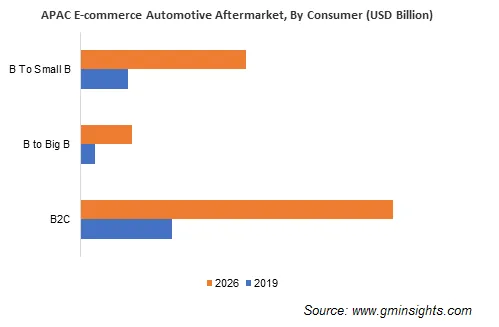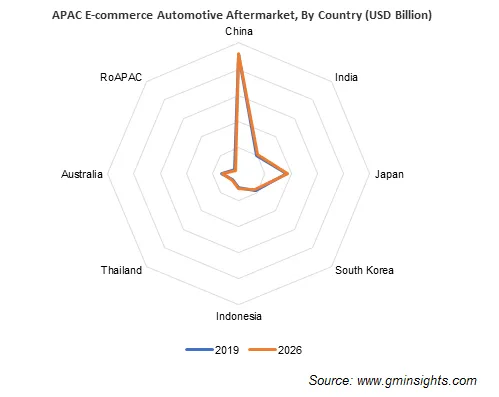


Asia Pacific E-commerce Automotive Aftermarket Size By E-commerce Retail (Third Party Retailers, Direct To Customer), By Product (Parts [Braking {Brake Pads, Hydraulics & Hardware, Rotor & Drum}, Steering & Suspension {Control Arms, Ball Joints, Tie Rods, Sway Bar Links, Bushings, Bearings/Seals, Coil Springs}, Hub Assemblies, Universal Joints, Gaskets, Wipers, Filters, Lighting, Spark Plug, Tires], Accessories [Interiors, Exteriors]), By Consumer (B2C, B to Big B, B to Small B), Industry Analysis Report, Regional Outlook, Growth Potential, Price Trends, Competitive Market
Get a free sample of this report
Your inquiry has been received. Our team will reach out to you with the required details via email. To ensure that you don't miss their response, kindly remember to check your spam folder as well!
Form submitted successfully!
Error submitting form. Please try again.

Request Sectional Data
Your inquiry has been received. Our team will reach out to you with the required details via email. To ensure that you don't miss their response, kindly remember to check your spam folder as well!
Form submitted successfully!
Error submitting form. Please try again.
APAC E-commerce Automotive Aftermarket size surpassed USD 10 billion in 2019 and will grow at a CAGR of over 15.3% from 2020 to 2026. Increasing awareness of e-commerce channels for buying automotive parts will drive the industry growth. The growing penetration of internet in Asia has played a key role in stimulating demand. Moreover, the development of easy communication and transaction channel owing to the development in IT will further fuel the market demand.
Development of mobile-friendly interface for part selection has surged online sales of automotive products. In 2019, mobile transactions held over 15% share in the overall transactions. Increasing investments by industry players in ERP, vendor management, and effective CRM will escalate growth. Manufacturers in the region are adopting omnichannel for improving product sales.

The rising number of automobile OEMs, increasing online auto-parts launches, and shifting consumer preferences are the current trends positively influencing the automotive aftermarket players. Monitor, control, and trigger post-order plan of action to boost product sales are among key strategies of industry players.
| Report Attribute | Details |
|---|---|
| Base Year: | 2019 |
| Asia Pacific E-commerce Automotive AfterMarket size in 2019: | USD 10.01 Billion |
| Forecast Period: | 2020 to 2026 |
| Forecast Period 2023 - 2032 CAGR: | 15.3 |
| 2023 Value Projection: | USD 34.46 Billion |
| Historical Data for: | 2016 to 2019 |
| No of Pages: | 250 |
| Tables, Charts & Figures: | 330 |
| Segments Covered: | E-commerce Retail, Product, Consumer, Country |
| Growth Drivers: |
|
| Pitfalls Challenges: |
|
The establishment of superior logistics channel improving the supply chain is a key factor supplementing business growth. Retailers are enabling cross-channel inventory management, improving optimization, and sufficing the customer demand. In addition, participants are focusing on reducing the cost required for logistics. Tie-ups with logistic channel providers will further boost the regional demand.
According to the official draft of National People Congress of China 2016, the country has established e-commerce laws to strengthen its regulatory environment, which is inclusive of both domestic and cross-border trade. These regulations keep a check on unauthorized trades and promote competitive environment.
Industry participants are considering various consolidation-related activities to secure and fuel customer base. Startups and service providers are improving the product portfolio to establish a foothold. The key focus points of market players are improving the product reach to customers and achieving economies of scale.
In light with the ongoing COVID-19 crisis, the APAC e-commerce industry has witnessed an exponential growth in terms of online orders and transactions over the last few months. The e-commerce industry has witnessed more than 60% increase in the orders between March and June 2020 compared to the same period in 2019. It can be ascribed to inaccessibility of offline channels due to the imposed regulations and a state of panic purchase due to the pandemic.
Cybersecurity threat is increasingly challenging the e-commerce automotive aftermarket industry. Customer data with e-commerce firms is increasing at a rapid pace, and incremental services will provide more specific data in the next decade. Access to this data has made the retail industry the primary target for cyberattacks, thereby hampering the market outlook.
APAC third-party retailers market size crossed over USD 9.5 billion in 2019 and is likely to grow at a decent growth rate of 15.2% through 2026. The emergence of online shops, such as Alibaba.com, Amazon, eBay, Mannkando, RockAuto, etc., has enhanced the segment growth.
Fiscal benefits including EMI, return policy, same-day delivery, and availability to compare product specifications will remain the key factors influencing demand. The rising preference for Do-It-Yourself (DIY) among consumers is another factor propelling demand. Increased expenditure by e-retailers due to convenience in online shopping will create lucrative opportunities for industry growth.
Replacement parts segment is projected to captured over 85% of the APAC e-commerce automotive aftermarket share in 2026. The rising trend of lightweight automotive production has led to the installation of enhanced components to improve efficiency of vehicles, which will provide a strong business outlook.
Improved demand for lighting systems, such as lighting mounted or rear side, integrated front side, and signaling, will support the segment growth. An increased consumer spending on e-commerce websites owing to accessibility of automotive components at competitive prices along with features, such as same-day delivery and pick up from the nearest stores, will boost market revenue.

B2C consumers constitute nearly 60% of the APAC consumption. Increasing DIY trend to replace automotive components will subsequently boost the adoption of e-commerce channels. Well-informed customers with advanced technical knowledge on part selection and dimensional standardization is the key factor fueling the industry demand. The industry players are focusing on offering information for part replacement with provision of part replacement manuals and videos on online portals. The availability of low-cost components is a key driving feature of the B2C segment in Asia Pacific E-commerce automotive aftermarket.

The China E-commerce automotive aftermarket is likely to cross around USD 16.20 billion revenue by 2026. The increasing number of smartphone users, internet connectivity, the escalating automobile industry, and demand for international brands will stimulate the regional demand. Consumers are highly cost-sensitive and thus prefer competitive pricing in automotive parts for repair & maintenance and service of vehicles.
Manufacturers are actively adopting digitalization strategy to offer buyer guides, journals, catalogs, updates on marketing initiatives, and detailed product-related information on the portal. The establishment of e-stores in growing nations, such as Vietnam, India, Indonesia, and Japan, offering various brands via partner-distributor e-commerce portal will further expand industry growth.
The APAC industry is moderately consolidated owing to e-commerce giants, such as:
acquiring a considerable share. The competition is intense as brick & mortar stores are also entering the online market. The product providers compete on competitive pricing to gain customers. The quality of the product and compliance with regulatory norms are the major focus areas.
In October 2017, Alibaba Group announced a ban on the listings offering car airbag components to avoid the counterfeiting of products. This strategy helped the company to enhance its customer base due to its focus on consumer safety.
Other notable players operating in the industry include Amazon, AutoZone, Bosch, Denso Corporation, eBay, Flipkart, NAPA Auto Parts, RockAuto, and Mannkando.
This research report on APAC E-commerce automotive aftermarket includes in-depth coverage of the industry with estimates & forecast in terms of volume in Thousand Units and revenue in USD million from 2016 to 2026, for the following segments:
The above information is provided on a country basis for the following:
The China market revenue is projected to exceed USD 16.20 billion through 2026 owing to the enhanced internet connectivity and an increasing number of smartphone users.
The APAC e-commerce automotive aftermarket revenue exceeded USD 10 billion in 2019 and is expected to register over 15.3% CAGR through 2026.
The replacement parts segment is expected to capture more than 85% of the APAC e-commerce automotive aftermarket revenue in 2026 due to the rising trend of lightweight automotive production and increased consumer spending on e-commerce website.
APAC industry size from third-party retailers surpassed USD 9.5 billion in 2019 and is projected to grow at a 15.2% rate through 2026 due to the rising preference for DIY among consumers and increased expenditure by e-retailers.